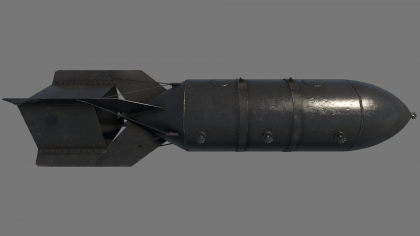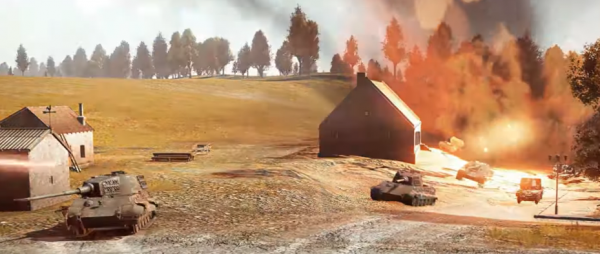Difference between revisions of "FAB-5000 (5,000 kg)"
(Extended the history and media parts of the FAB-5000) (Tag: Visual edit) |
(→History) (Tag: Visual edit) |
||
| Line 74: | Line 74: | ||
== History == | == History == | ||
<!-- ''Examine the history of the creation and combat usage of the weapon in more detail than in the introduction. If the historical reference turns out to be too long, take it to a separate article, taking a link to the article about the weapon and adding a block "/History" (example: <nowiki>https://wiki.warthunder.com/(Weapon-name)/History</nowiki>) and add a link to it here using the <code>main</code> template. Be sure to reference text and sources by using <code><nowiki><ref></ref></nowiki></code>, as well as adding them at the end of the article with <code><nowiki><references /></nowiki></code>.'' --> | <!-- ''Examine the history of the creation and combat usage of the weapon in more detail than in the introduction. If the historical reference turns out to be too long, take it to a separate article, taking a link to the article about the weapon and adding a block "/History" (example: <nowiki>https://wiki.warthunder.com/(Weapon-name)/History</nowiki>) and add a link to it here using the <code>main</code> template. Be sure to reference text and sources by using <code><nowiki><ref></ref></nowiki></code>, as well as adding them at the end of the article with <code><nowiki><references /></nowiki></code>.'' --> | ||
| − | + | The bomb was designed by Soviet chemical engineer Nison Gelperin [ru] (1903-1989) in 1942. Gelperin projected and built bombs with tiny metal casings, in order to reduce the use of cast iron and aluminium. In Gelperin's developments, the metal casings represented only 35 percent of the bomb's weight. | |
| + | |||
| + | By 1942, the State Defense Committee of the Soviet Union perceived the need of weapons that could hit hard industrial and military facilities, marshaling yards and fortifications, without the usual scattering of medium-weight bombs. The first attempt came in the form of an explosive unmanned aircraft, a modified version of the TB-3, but the trials of this flying bomb were less than satisfactory. | ||
| + | |||
| + | The Directorate of Logistics of the Air Forces eventually requested to Gelperin the development of a five-ton bomb, capable of being dropped by the Pe-8, the heaviest Soviet bomber of the time. The definitive version of the FAB-5000 was fitted with six contact lateral fuses, and the warhead was filled with 3200 kg (7055 lb) of an explosive mixture of TNT, RDX, and aluminium powder. The number of fuses ensured that the force of the blast would disperse laterally, which increases the damage in areas such as industrial compounds and military facilities. In order to load the device, the bomber's bay doors had to remain half-open. The tests, however, were successful. Two bombs were dropped, one from an altitude of 4,000 m and the other from 3,300 m. The first bomb fell in open ground, leaving a crater 6 metres (20 ft) in diameter and 3 metres (9.8 ft) in depth. Grass in a radius of 150 m was charred. The second bomb landed in the woods, and left a crater of 8 metres (26 ft) in diameter and 3 metres (9.8 ft) in depth. Some 600 trees were torn out within a 70 m radius, while 30 percent of the trees within 135 m also fell down. Later tests produced craters up to 20 metres (66 ft) in diameter and 9 metres (30 ft) in depth. The project was brought to the assembly line and the bomb was hastily put in service on 15 February 1943. By the end of the war, 98 FAB-5000s had been delivered to the Soviet Air Forces, all of them produced in 1943. | ||
== Media == | == Media == | ||
Revision as of 23:17, 24 February 2023
Contents
Description
The FAB-5000 is a Soviet high explosive (HE) bomb. It was the largest bomb of the Soviet arsenal during WW2.
Vehicles equipped with this weapon
General info
| Bomb characteristics | |
|---|---|
| Mass | 5,080 kg |
| Explosive mass | 3,361 kg |
| Explosive type | TGA-16 |
| TNT equivalent | 5,041.5 kg |
| HE max penetration | 350 mm |
| Destruction radius | 105 m |
| Fragment dispersion radius | 370 m |
Effective damage
With a huge destruction radius of 105 m, nothing that stands near the FAB-5000 is likely to survive. Simply aiming the bomb near a capture zone will guarantee destruction of anything inside of it (this also applies to teammates so be careful!). The fragment dispersion is very effective even past 200 m thanks to almost 2 tons of steel surrounding the TGA-16 explosive filler, more than enough to kill lightly armoured vehicles such as SPGs and SPAA or at least damaging crew. It is important to set a fuse of at least a couple of seconds or to bomb from high altitudes as any planes near the bomb are likely to take critical damage.
Comparison with analogues
No other bomb in-game compares to the destructive power of the FAB-5000. The nearest counterpart is the Soviet FAB-3000M-46, and the German SC2500 (2,500 kg).
Usage in battles
The FAB-5000 is commonly used for destroying airfields in Air battles, however this requires other bombers in the team to take out bases first. Since the Pe-8 can only carry a single bomb it would be a waste to just use it on a single base.
The FAB-5000 shows its strength best in Ground battles where it is commonly referred to as the "Nuke" due to its large explosive mass. The Pe-8 is easy to shoot down when at low altitude as it is a heavy strategic bomber, and it's safer to bomb from high altitudes where the Pe-8 is far enough away to not be damaged by the bomb's splash damage, even without a fuse. The easiest targets to aim for are capture points as these are the most important areas for tanks to be inside, unfortunately for the tanks by being near the capture point they are very visible from above. Once there are multiple tanks inside of the capture point, the FAB-5000 is the perfect weapon for taking them all out in a single strike as the explosive mass is enough to kill everything inside of it. Meanwhile, the Pe-8 can stay at high altitudes where it is safe from enemy fighters.
Pros and cons
Pros:
- Massive explosive mass means precision is not needed
- 105 m lethal radius
- Fragment dispersion radius is large enough to kill un-armoured targets from way beyond the lethal range for armoured targets
- Even the fastest vehicles don't have time to get away from the explosion once the bomb lands
Cons:
- Due to the bomb being so heavy the Pe-8 carrying it is unable to accelerate to high speeds or climb very high
- The Pe-8 is vulnerable to SPAA
- Low altitude bombing is almost impossible due to the explosion being enough to kill the Pe-8 if it is too close.
- Due to being restricted to high altitude bombing enemies have to stay in the same place for a long time
- The FAB-5000 can be shot down by planes and tanks leading to the bomb to explode mid-air
- Without proper communication, teammates are at high risk of being killed by the bomb
History
The bomb was designed by Soviet chemical engineer Nison Gelperin [ru] (1903-1989) in 1942. Gelperin projected and built bombs with tiny metal casings, in order to reduce the use of cast iron and aluminium. In Gelperin's developments, the metal casings represented only 35 percent of the bomb's weight.
By 1942, the State Defense Committee of the Soviet Union perceived the need of weapons that could hit hard industrial and military facilities, marshaling yards and fortifications, without the usual scattering of medium-weight bombs. The first attempt came in the form of an explosive unmanned aircraft, a modified version of the TB-3, but the trials of this flying bomb were less than satisfactory.
The Directorate of Logistics of the Air Forces eventually requested to Gelperin the development of a five-ton bomb, capable of being dropped by the Pe-8, the heaviest Soviet bomber of the time. The definitive version of the FAB-5000 was fitted with six contact lateral fuses, and the warhead was filled with 3200 kg (7055 lb) of an explosive mixture of TNT, RDX, and aluminium powder. The number of fuses ensured that the force of the blast would disperse laterally, which increases the damage in areas such as industrial compounds and military facilities. In order to load the device, the bomber's bay doors had to remain half-open. The tests, however, were successful. Two bombs were dropped, one from an altitude of 4,000 m and the other from 3,300 m. The first bomb fell in open ground, leaving a crater 6 metres (20 ft) in diameter and 3 metres (9.8 ft) in depth. Grass in a radius of 150 m was charred. The second bomb landed in the woods, and left a crater of 8 metres (26 ft) in diameter and 3 metres (9.8 ft) in depth. Some 600 trees were torn out within a 70 m radius, while 30 percent of the trees within 135 m also fell down. Later tests produced craters up to 20 metres (66 ft) in diameter and 9 metres (30 ft) in depth. The project was brought to the assembly line and the bomb was hastily put in service on 15 February 1943. By the end of the war, 98 FAB-5000s had been delivered to the Soviet Air Forces, all of them produced in 1943.
Media
In game video of the Russian Pe-8 dropping the FAB-5000: https://www.youtube.com/watch?v=8V-sU8Sw0VI
See also
External links





